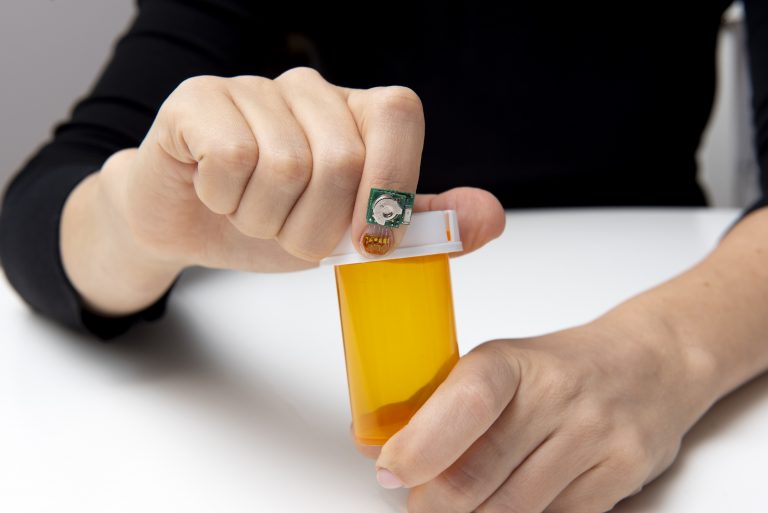 EMERGING TECH
EMERGING TECH
 EMERGING TECH
EMERGING TECH
 EMERGING TECH
EMERGING TECH
Researchers at IBM Corp. have developed a miniature sensor that can glean insights into people’s health from their fingernails.
The project, which the company announced today, could add momentum to growing adoption of wearable technology in the healthcare field.
Apple Inc. also moved to address this burgeoning opportunity recently by adding an electrocardiogram function to the Apple Watch 4. But whereas the smartwatch is limited to tracking heart activity, IBM’s new sensor has a potentially far broader range of applications.
The device (pictured) is comprised of two components. The first is a compact computer that sits atop a user’s finger, while the other is an array of strain gauges meant to be attached to the fingernail. The strain gauges record the subtle ways the fingernail moves and changes its shape as the wearer uses their hands.
“We interact with objects throughout the day using our hands, such as the tactile sensing of pressure, temperature, surface textures and more,” IBM researchers Stephen Heisig and Katsuyuki Sakuma wrote in a blog post. “Our team realized it might be possible to derive interesting signals from how the fingernail bends throughout the course of a day, as we use our fingers to interact with our environment.”
Specifically, these fingernail changes can be analyzed to measure a person’s grip strength. Grip strength, in turn, is a metric useful for assessing a broad spectrum of medical conditions.
One use case that IBM sees for the sensor is monitoring the health of Parkinson’s patients. The strain gauges can identify fluctuations in the frequency and intensity of hand tremors, data that could potentially help doctors make better care decisions. Grip strength has also proven to be valuable for evaluating the progression of diseases such as heart disease, as well as for detecting psychological stress.
The current iteration of the sensor is designed to be used with a smartwatch. The smartwatch processes the data using artificial intelligence algorithms that IBM has developed specifically for the project.
According to the company, its AI can not only identify abnormal movements but also distinguish between different activities. The software is accurate enough to tell, among other things, if the user is writing and even determine when they’re drawing numerical digits. Heisig and Sakuma said that granularity could potentially enable the sensor to double as a communications aid for people with disabilities.
Support our open free content by sharing and engaging with our content and community.
Where Technology Leaders Connect, Share Intelligence & Create Opportunities
SiliconANGLE Media is a recognized leader in digital media innovation serving innovative audiences and brands, bringing together cutting-edge technology, influential content, strategic insights and real-time audience engagement. As the parent company of SiliconANGLE, theCUBE Network, theCUBE Research, CUBE365, theCUBE AI and theCUBE SuperStudios — such as those established in Silicon Valley and the New York Stock Exchange (NYSE) — SiliconANGLE Media operates at the intersection of media, technology, and AI. .
Founded by tech visionaries John Furrier and Dave Vellante, SiliconANGLE Media has built a powerful ecosystem of industry-leading digital media brands, with a reach of 15+ million elite tech professionals. The company’s new, proprietary theCUBE AI Video cloud is breaking ground in audience interaction, leveraging theCUBEai.com neural network to help technology companies make data-driven decisions and stay at the forefront of industry conversations.